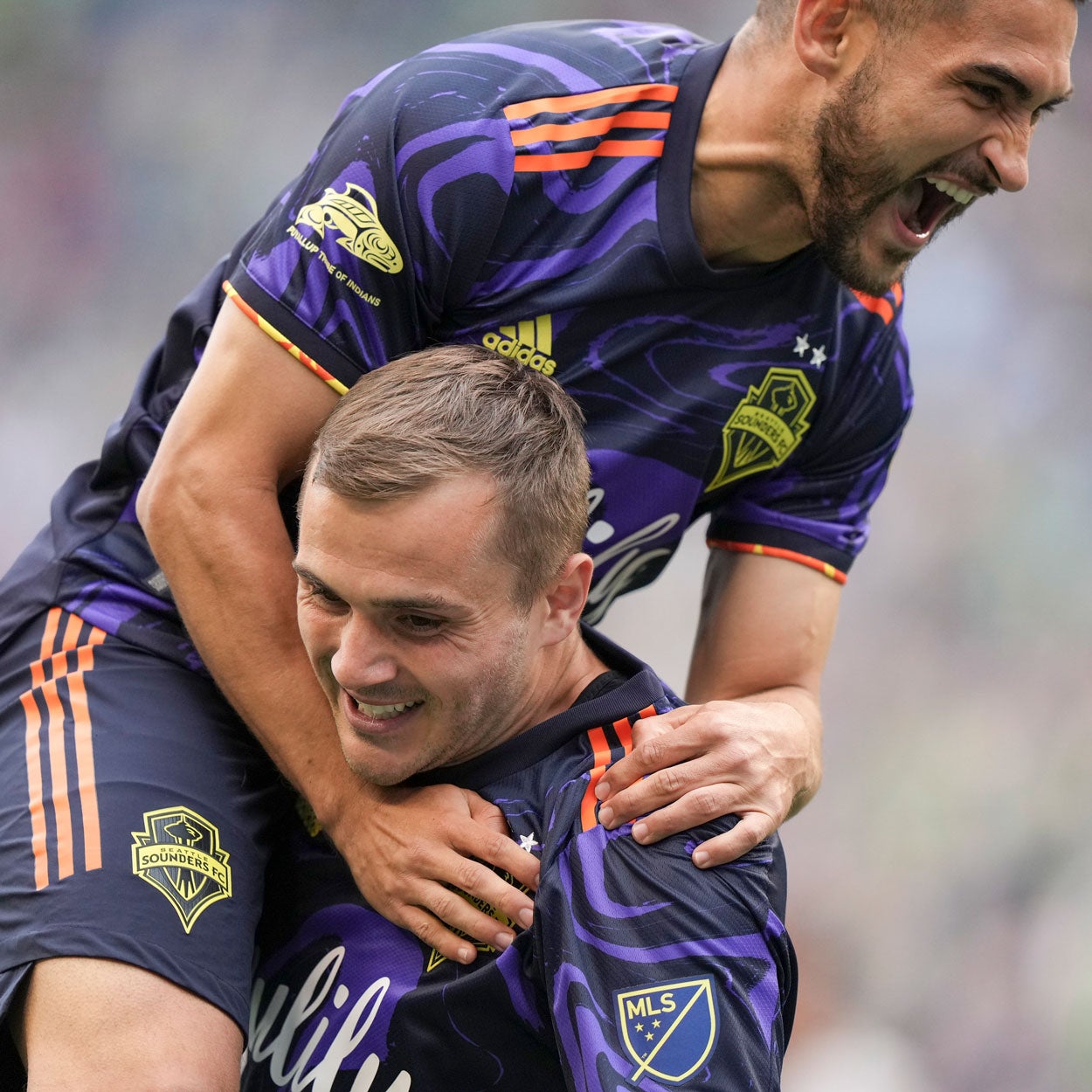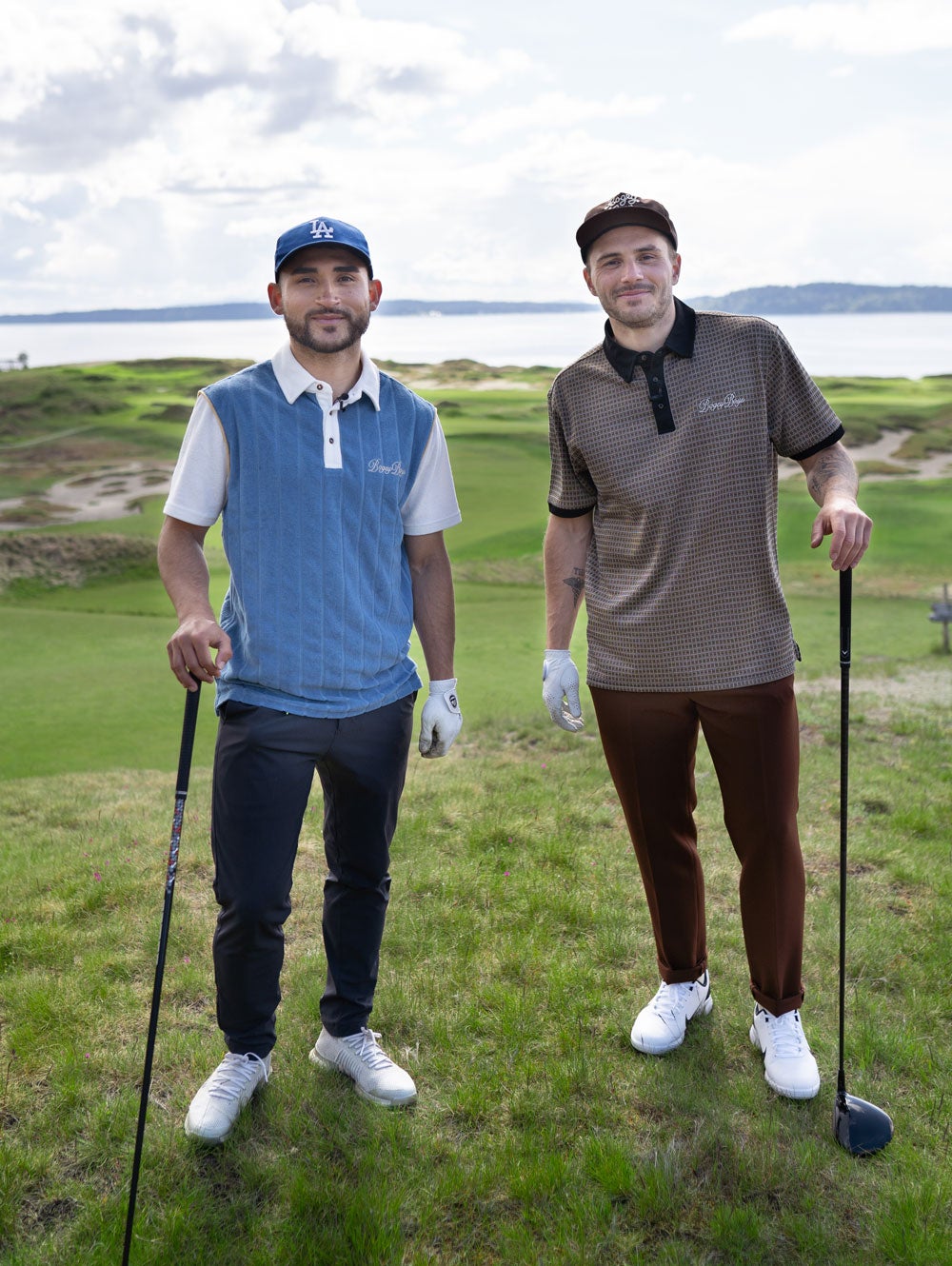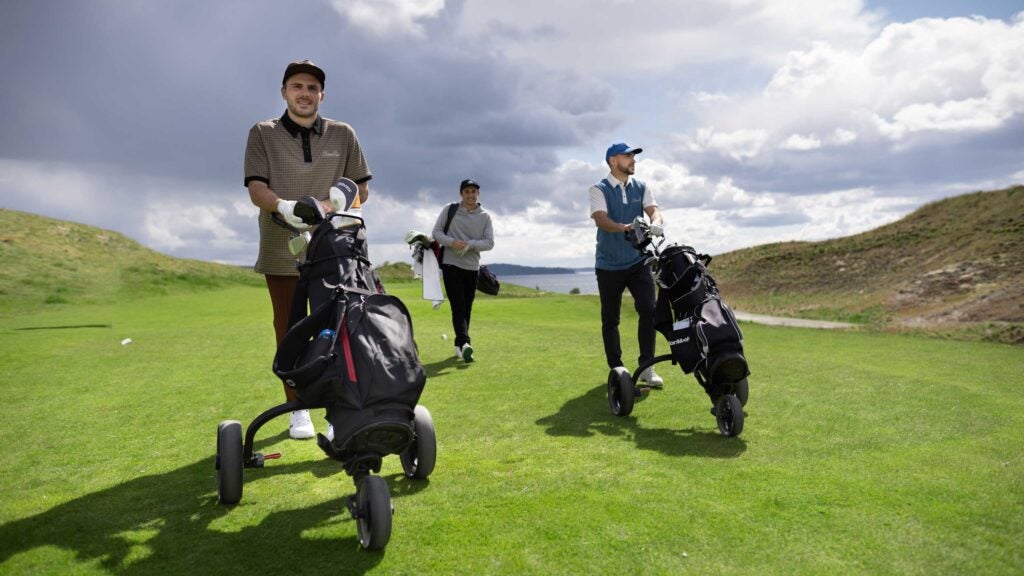I ushered my two new golfing friends to the edge of the overlook.
One stood open-mouthed. The other laughed out loud.
“Bro,” he said. “I didn’t even know golf courses could look like this.”
The wild dunescape of Chambers Bay Golf Course opened up before us. The par-3 ninth, which features a precipitous 100-foot drop from tee to green, was in the foreground. The rest sprawled out beyond. Looking right to left, there was the hillside eighth, the duneside 10th, the seaside 17th. From our spot beside the clubhouse you could see at least a portion of every single hole.
I moved to Seattle two years ago and this particular ritual — giving first-timers the big reveal at Chambers — has become one of my favorites. If you can picture a links course built on an abandoned planet from Star Wars, you’re on the right track. Massive waste bunkers line massive fairways, with massive dunes dividing one hole from the next. No other course has anything like the enormous stone structures that mark the course’s northern border, imposing reminders of the landscape’s former life as a gravel pit. Look past those and you’ll see non-golfers walking down to the beach, with the Puget Sound beyond. Occasionally whales will make it this far south in the Sound; on clear summer days you can spot them from the 16th fairway.
Most courses in the Seattle-Tacoma area are what the locals call “bowling alleys” because their narrow fairways are walled in by colossal pines. The trees occasionally serve as bumpers, conveniently nudging your ball back into play, but more often they’re gutters, seizing your ball and wrecking your score. But not at Chambers, where there’s exactly one tree on the property. And it’s not even in play.

My two new friends weren’t bowlers. They’ve only recently considered themselves golfers. These were soccer stars, two of Seattle’s finest, two of America’s finest, forward Jordan Morris and midfielder Cristian Roldan, each 27 years old. Both play for the Sounders and for the U.S. men’s national team, but their Seattle golf haunts are decidedly humble — they’ve grown accustomed to the tree-lined fairways of local munis like Jefferson Park, where Fred Couples grew up.
Like Couples, the game had captured their attention and imagination despite a modest playing field. But now, gazing over the host course of the 2015 U.S. Open, two men accustomed to competing in front of tens of thousands looked wide-eyed as they geared up for a round with exactly zero stakes.
“Not gonna lie, I’m a little intimidated,” Roldan said.
I’d been introduced to Jordan and Cristian through a mutual friend and jumped at the chance to play together. They were eager to expand their golfing horizons; both started playing in earnest at the beginning of the pandemic, seeking an escape and safe, outdoor competition. And I, a new Pacific Northwest resident, was eager to spend some time with Seattle sports royalty, to pick their brain on soccer-golf comparisons and to get their answers to my favorite question of all: Why golf?
SEATTLE’S ADOPTED SON
Cristian Roldan arrived at Chambers Bay in a stylish terrycloth polo — white sleeves, blue body, Bogey Boys emblazoned on the chest — and a well-worn Los Angeles Dodgers hat.
The hat was a nod to his past. Cristian was born in southeast L.A. County and raised in Pico Rivera, a mid-sized city whose population is more than 90 percent Hispanic or Latino. His mother Ana grew up in El Salvador and his father Cesar emigrated from Guatemala, each searching for a better life. They met in Los Angeles when Cesar, who worked a series of odd jobs, helped move Ana’s aunt into an apartment. The two were married in 1989. They moved to a house with a long, narrow strip of grass in the backyard. After their sons were born, Cesar built backyard goals out of PVC pipes so the three boys could play and dream.
In hindsight, Cristian was destined for soccer stardom from the start. When he was nine, his juggling skills won him a spot in an Adidas commercial. During his sophomore year at El Rancho — where he, his older brother Cesar, Jr. and younger brother Alex all starred — Cristian won Player of the Year honors in southern California. The Roldan boys became legends in Pico, and Cristian in particular just kept getting better. His senior year, he logged a preposterous 54 goals and 31 assists during a 29-2-1 campaign and was named Gatorade National Boys Soccer Player of the Year, incredible accomplishments that served as a testament to his decision to stick it out at El Rancho rather than leave for one of the sport’s more heralded academies or junior programs. But that decision also meant he slipped through the cracks of big-time recruiting.


“I really didn’t think I was going to play college soccer,” Roldan explained as we walked down the 11th fairway. “I didn’t have a single offer until Signing Day, and then it was just two: Cal St. Bakersfield and the University of Washington.” He eagerly signed on as a Husky, moved to Seattle and hit the pitch running. Roldan won Pac-12 Freshman of the Year, edging out Morris. The secret was out on the 5-foot-8 sparkplug who wanted the ball in the biggest moments.
After two terrific years, Roldan decided to turn pro. He’d proved any doubters badly wrong and now was expected to go as high as No. 2 overall in the MLS Superdraft. But when draft day came he fell, and fell, and fell. Roldan had been overlooked again. And once again, Seattle swooped in to bring him home. The Sounders, familiar with his work at UW, made a move to get him at No. 16.
“I just kept slipping in the draft,” he remembered. “And Seattle made a trade during the draft and took me.”
The rest is history. Seattle has adopted Roldan, and he’s adopted it back. That’s where his shirt comes in; it’s a nod to his present. Bogey Boys is a Seattle-based company founded by Macklemore, the performing artist who is a part-owner of the Sounders. It doesn’t take long to recognize that Cristian is fiercely loyal.
“Seattle has given me an opportunity that I don’t think I would have gotten anywhere else,” he said.


SEATTLE’S LIFELONG SON
As we approached the first tee, the starter greeted Jordan Morris excitedly.
“Your dad did my knee!” he said.
That sort of thing, he admitted later, happens all the time. His father Michael is an orthopedic surgeon who has served as the Sounders’ team doctor since the franchise’s USL days, which predated Seattle joining the MLS in 2008. Morris grew up around the team and played for the Sounders’ youth academy. When it came to choosing Seattle soccer, well, there was no choice. It was in his DNA.
“I remember going to that first game when the Sounders became an MLS team and telling myself I really wanted to be on that field playing someday,” Morris said.
He did leave the state for a few years to attend Stanford, where he led the Cardinal to a national championship and won National Player of the Year. In 2016, he signed with the Sounders and made his debut shortly thereafter, making good on his childhood goal. (Sidenote: like Roldan, Morris is fiercely loyal, too, and loves his hometown. Two of his best friends from childhood, James and Logan, are still two of his best friends today. They run Montane Productions, a video production studio, and met us at the course to take the striking photos and videos for the story you’re reading now.)
“To have that happen in front of my family and my friends was literally a dream. And it still is,” Morris said. “I have my dad still on the sideline, too. And to be around my family, my parents who sacrificed so much, who drove me to Spokane and back, who made it all happen? That’s pretty cool.”


Morris actually did have a choice. Opportunities opened up well beyond the limits of the Emerald City, and after Stanford, some expected him to sign with German club Werder Bremen, where he’d spent time training. He followed his heart back to Seattle instead, signing a “Homegrown” contract. In the half-decade since, Morris has starred for Seattle and for the U.S. Men’s national team as well as on loan for Swansea City. His game travels.
That’s not to say it has all been easy. When Morris was 9 he was diagnosed with Type 1 diabetes, a condition that requires constant and careful management. It has made his rise to the top that much more impressive. Injuries have interrupted his career, too: In 2018, he tore his ACL. In 2021, he tore it again. His on-field glory has been earned, and re-earned, and earned again.
WHERE SOCCER MEETS GOLF
Although they’ve become steadfast golf buddies, don’t expect Roldan/Morris to pop up as a Ryder Cup pairing anytime soon. Roldan regularly breaks 90, while Morris is a few shots higher. But they’ve played more than enough to learn some of the game’s secrets, frustrations and temptations.
I pressed them for soccer-golf comparisons. Working the ball both ways, I thought. Using the ground. Playing different trajectories. Making solid contact. But their own selections spoke to something deeper.
“It’s such an imperfect sport, soccer. You’re going to lose the ball all the time,” Morris said. “I remember my college coach saying, ‘next play, next play. We’re moving on.’ I feel like that’s even more important in golf; you hit a bad shot and you have to move on to the next one. And for me, that’s tough.” He said the last part with a grin.
Roldan’s mind went to game management.
“Coaches always say, when you make a mistake, play the easy pass,” he said. “And in golf, you always want to be the hero. The reality is, when you’re in a pickle, we should all be chipping out and making the easy pass.”

For the most part, a round with Morris and Roldan might look, feel and sound just like your foursome. The two traded good-natured banter all afternoon, knocking each other down if one got too high but building each other up when Chambers proved particularly tough.
“Sometimes we lose Jordan early in the back nine,” Cristian said.
“That’s true,” Morris agreed. “Cristian likes to keep me in it.”
There are other ways their round might look slightly different, depending on your Saturday foursome. There are no Coors Lights nor Rainiers, for one thing.
“When we play, there’s no alcohol,” Morris explained. “We’re already handicapped by how bad we are.”
They also always ride in golf carts, so they can save their legs for slightly more important matters. Because Chambers doesn’t do golf carts, our afternoon’s up-and-down hike was quite an initiation — before our round, in fact, neither had ever actually walked 18 holes. Cognizant of his blood sugar, Morris busted his way through several bags of popcorn, his preferred snack for regulating his levels. And Roldan, who has always been notably fit, was amazed at just how tiring it was. We’d trekked roughly seven miles by day’s end, which is about what he would run over the course of a soccer game.
“Those guys do it four days in a row? I know they build that stamina up, but especially when it’s hot? That’s almost 30 miles of walking over a tournament. That’s crazy,” he said.
Their athleticism was obvious, even if it didn’t translate directly to low scores. Playing the par-3 third, Roldan turned particularly hard on a 7-iron and sent it screaming over the flag, over the green and over the dune behind it, too, carrying some 200 yards and bounding 30 more.
“But sometimes it goes 150,” he said, shaking his head.
Morris spent more time than he’d planned in Chambers’ endless array of sand, which is easy to find but tough to escape. His expectations are high, befitting someone with his level of athletic achievement, but the realities of golf kept hitting back.
“This is the hardest course I’ve ever played, for sure,” he said.
But then we reached the 15th hole, Chambers’ iconic short par-3. The sun was getting lower, casting a satisfying reflection off the Puget Sound behind the green. Morris pulled 9-iron and striped it directly at the pin. It settled just three feet away. He turned to me, attempting to hold in his delight.
“That’s how I’ve been hitting all day,” he said. Then he cracked up. “I honestly thought that might go in.”
How many shots had he hit in his life better than that one?
“I don’t think any. I think that’s the best one. With that view, too? I think you’d call that one the best ever.”
Then, of course, golf brought him back to earth. His birdie bid started right and stayed right, catching the edge of the cup and spinning painfully out the side. Shell-shocked and heartbroken, he missed the follow-up par putt, too.
“I’ll take a bogey, I guess,” he said as Cristian cackled in the background.
WHY GOLF?
These days, Morris said, he’s practically giddy the night before a round.
“We’re such competitive people that golf allows us to still be competitive, whether it’s in between games or in the offseason,” he said. “It used to be video games. Now? It’s all golf.”
He started to add more. “I feel very at peace on the course,” he said, but Roldan cut him off with a look. Morris cracked up. “Okay, okay, not always. Definitely not when I’m struggling.”
Roldan picked up where his golf buddy left off. Golf, he said, provides an escape and a chance to destress away from the daily pressures of professional soccer.
“Soccer can be all-consuming. After a bad game you can just constantly be thinking about your mistakes. But by playing golf, we’re still competing. My brain isn’t turned off. That’s not the point. It’s turned on in a completely different way.”
Golf is a team-building exercise for these two; they traded tips on ball position and chipping form. They could have been a member-guest team or just two golf buddies, which made it easy to forget just how dynamic they are as a duo on the pitch. Some days before we teed it up they’d played key roles in the Sounders’ historic CONCACAF win over Pumas FC, and they’ve continued to fill up the stat sheets in the weeks that have followed. One particular high point came in a 3-0 win over Sporting KC in which each had a goal and an assist. They’re each vying for spots on Team USA’s World Cup roster, too — the deadline comes Nov. 14.
That’s where golf’s importance shines through. It’s an escape from anyone’s expectations besides their own. They can watch while the pros do their thing — and they do watch. Their infatuation has spread to TV consumption, as both are hooked on the PGA Tour now, too.
“Playing and then going and watching them, you can truly appreciate the shots that they’re hitting,” Roldan said. “Understanding golf more makes you appreciate how incredible it is, what they’re doing.”
Each of them dutifully holed every putt, setting the gold standard for scorekeeping. No shaved strokes here. Roldan snuck in with 97, while Morris was just over 100. That mattered, but didn’t, as they soaked up the endless Seattle summer night.
“That’s one thing people don’t understand about it here,” Roldan said. “The anticipation after the winter and the rain — the vibes in Seattle in the summer are real.”
He spoke like a local. Morris nodded in approval. It was a moment brought to you by golf, a sport played outdoors, with friends. Where you play matters. Who you play with? Even more so. And on a good day, with the right crew, golf anywhere can feel like home.


